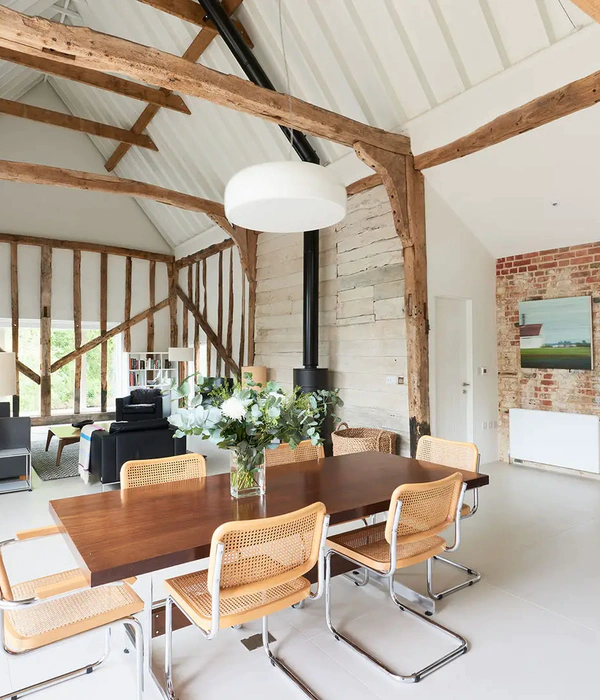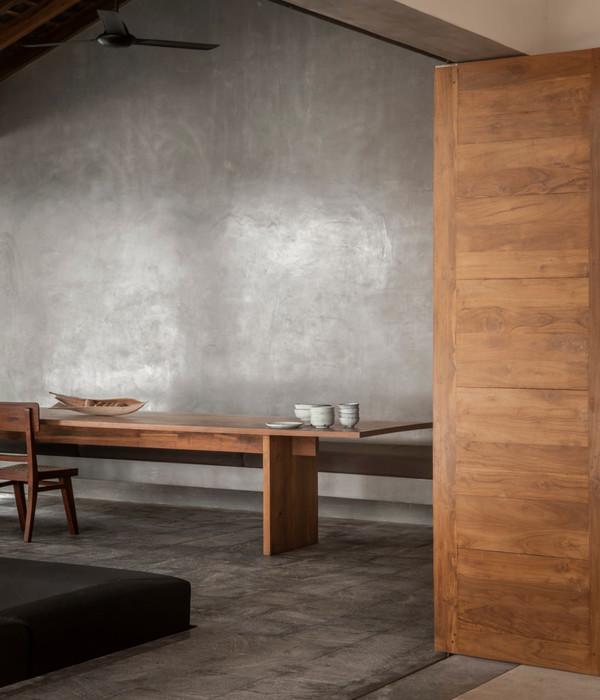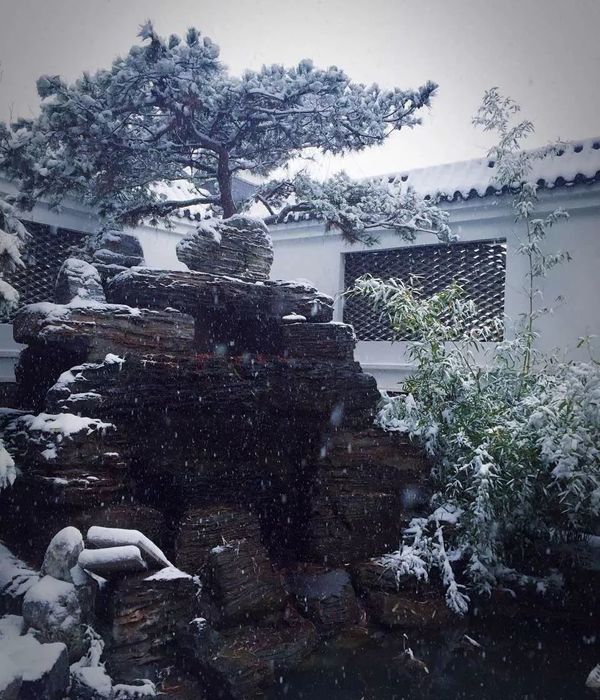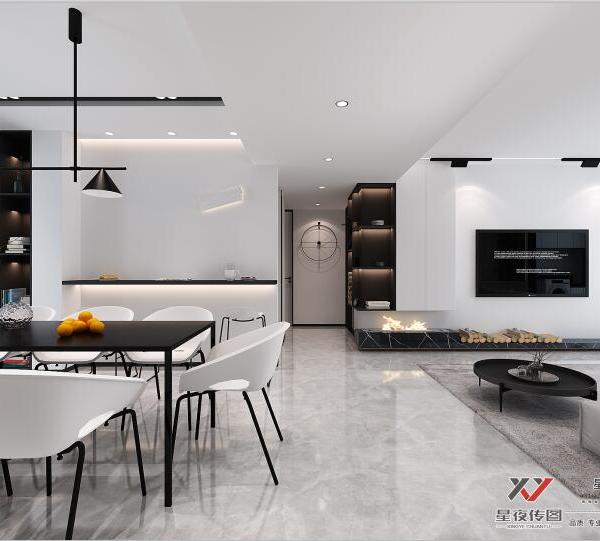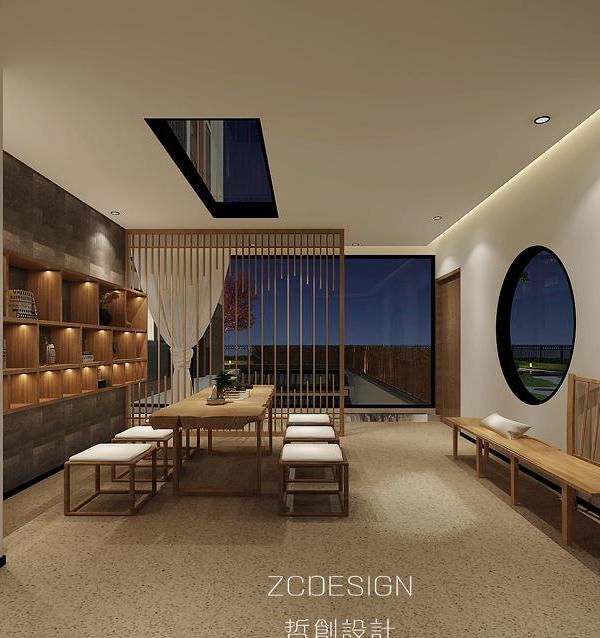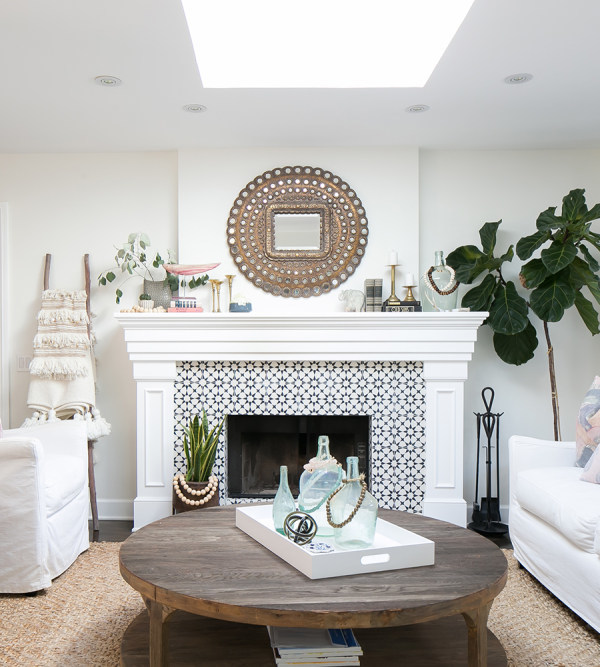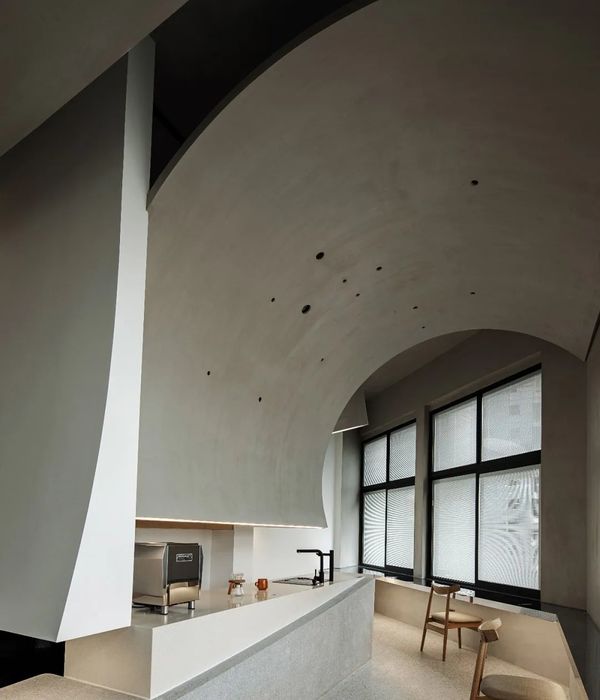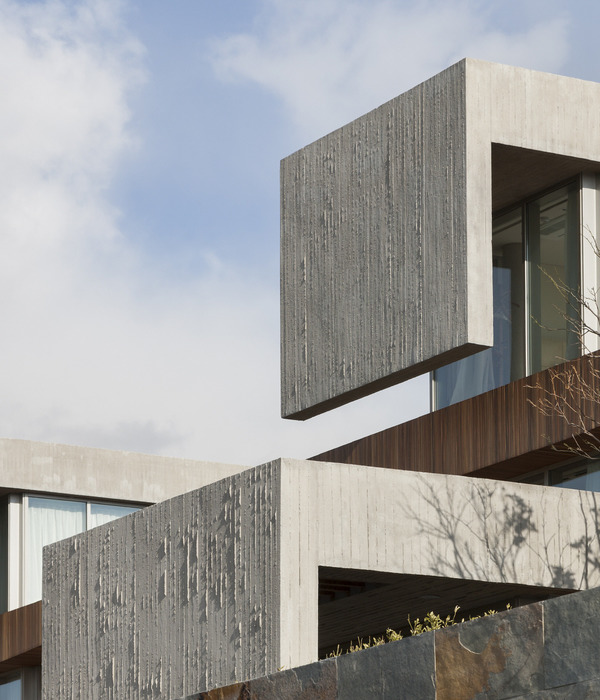- 项目名称:兰往-Ladésee Hotel
- 项目地址:大理·海西桃源村
- 设计总监:李万鸿
- 设计执行:任向东,陈彬彬,唐靓,罗晗,唐俊
- 结构设计:栾栌构造设计
- 照明设计:欧未照明
- 施工单位:太格尔装饰
- 项目面积:1000㎡
- 竣工时间:2021年7月
- 项目文案:十有八九
兰往-LadéseeHotel,坐落在大理环海西路的桃源村,一个宁静、质朴的白族村庄。这里东接洱海,南邻周城,向西便能望见苍山云弄峰。
Lan-Ladésee Hotel is located in Taoyuan Village, Huanhaixi Road, Dali, a quiet and pristine Bai village. It is bordered by Erhai Lake in the east, Zhoucheng in the south, and Yunong Peak of Cangshan Mountain can be seen to the west.
Hotel exterior view © 翱翔
房子建在离桃源码头不远的地方。面朝洱海,跨过门口的环海西路,便是近海漫灌向岸边的湖泊、夏日莲叶田田的荷景,以及生长于水中的湿地树林,再稍远些便是桃源码头。房子的背后是苍山,近处可见苍山脚下绵延的村落,以及人们春种秋耕土地。
The house is built facing the Erhai Lake. The Huanhaixi Road across the door is the lake that floods the shore, the lotus scenery of summer lotus leaf fields, and the wetland woods that grow in the water. A little further away is the Taoyuan Wharf. Behind the house is Cangshan Mountain, and the villages at the foot of Cangshan Mountain can be seen nearby, as well as people planting land in spring and autumn.
▼场地环境,Context© 翱翔
▼鸟瞰,Aerial view© 翱翔
这是一幢拥有三层楼高、带庭院和屋顶的近海民居房。
建筑的立面采用当地的石材,沉稳低调,质朴自然,表皮粗粝的肌理给人以独特的感知,唤醒着建筑与自然的亲近关系。白色的巨型飞翼作为现代建构工艺的产物,其形态却与传统的飞檐翘角相呼应。它起落在屋顶的上方,亦帆亦鸟,象征着自由,也意味着向往,并延展出对于居与旅的想象。
This is a three-story offshore residential house with a courtyard and a roof.
The facade of the building is made of local stone, calm and low-key, simple and natural, and the rough skin texture gives people a unique perception, awakening the close relationship between the building and nature. The white giant flying wing is a product of modern construction craftsmanship, but its shape echoes the traditional flying cornice. It rises and falls on the roof, sails and birds, which means freedom and yearning, and extends the imagination of living and traveling in it.
▼从道路望向酒店,View from the road© 翱翔
酒店立面,Hotel facade© 翱翔
重新凿墙辟窗,长条形的开窗方式在横向和竖向上为建筑的外立面带来平稳与简洁的现代性,方形的窗孔则随着窗框大小的变化为建筑注入呼吸感。深灰色的三角斜挑作为一种偶然,向外微微扩张,塑造着建筑的张力。
The windows are reopened. The rectangular window opening method in the horizontal and vertical directions brings clean and concise modernity to the building’s façade, while the square window openings inject a sense of breath into the building as the size of the window frame changes. The dark gray triangles are slanted as an embellishment, expanding slightly outwards, forming the tension of the building.
▼外立面细节,Facade detailed view© 翱翔
从当地石料中开采出来的石皮,或杂白或青绿或锈黄,以点缀的手法镶嵌于立面之上。自然的嶙峋表皮,彰显着来自山中之石的桀骜,输出在地性的同时,也给建筑增添了浑厚与质朴的气息。
Colored stone skins mined from local stones, or mixed white, turquoise or rusty yellow, are inlaid on the facade with embellishments. Natural rugged skin, reveals the unruly from the mountains of stone, while the output of the local characteristics, but also added a vigorous and rustic atmosphere to the building.
▼石皮和窗框细节,Stone sheet and window frame© 翱翔
从环海西路进入酒店前的浅巷,伴随着低矮的当地拼接式石头墙与延伸的巷道小景,白族传统的门头作为主入口伫立在浅巷的尽头,白色古朴的照壁透过门楣,形成景深式的视觉文化符号体验。
青砖青瓦、翘角飞檐,古朴而幽远,空间场所的在地性身份因此而显现。
Entering the shallow alley in front of the hotel from Huanhai West Road, along with the low local stone wall and extended lane landscape, the traditional door of the Bai nationality stands at the end of the alley as the main entrance. White quaint screen wall through the doorway, forms a depth-of-field visual experience with cultural symbol.
The blue bricks, blue tiles, and angled cornices are quaint and quiet, and the identity of the locality space is thus revealed.
▼白族传统的门头,The traditional door of the Bai nationality © 翱翔
与此同时,院落格局从传统进出方向的排列上被挪转为并列的横向结构,传统性作为一种文化元素与美学氛围,得到灵活取用。
The courtyard layout has been shifted from the traditional arrangement to the parallel horizontal structure. Tradition, as a cultural element and aesthetic atmosphere, is used flexibly.
▼轴测分解图,Axon exploded©相上文象
院落被置于传统照壁与门头之间,流动的水景均匀分布于以入口为核心的两旁,水中的卧石与粗质陶缸分别安置在两个水景之中,形成延绵山势与水中圆月的缩影。
青灰色的地面介于传统性与现代性的中间地带,与房子外立面的石材以及传统门头照壁的灰色,形成流畅的视觉延伸性体验。
The courtyard is placed between the traditional wall and gate, and the landscapes with flowing water is evenly distributed on both sides with the entrance as the core. The lying rocks and the coarse pottery jars in the water are placed in two water-scapes respectively, forming the epitome of the rolling mountains and the full moon in the water.
The blue-gray ground lies between the traditional and the modern, and forms a smooth visual extension experience with the stone on the facade of the house and the gray of the traditional gate and wall.
▼院落,Courtyard© 翱翔
院子以或抬高或下沉的方式在水平方向上向南端延伸,延伸至白色抿石铺地的后花园。水池旁的五彩石矮片墙与连通后门的院墙,围合成休闲的花园一隅。
洁净的户外沙发,杂植以现代植物与花卉,羽毛枫、月季、绣球,并设一座户外的取暖壁炉。在景观氛围的营造上,稍稍与正门的水景庭院拉开距离,以此建立起在感受上的丰富度与差异性。
The yard extends to the south by raising or sinking, extending to the back garden on the white stone ground.
The clean outdoor sofa, mixed plants with modern plants and flowers, feather maple, rose, hydrangea, and an outdoor heating fireplace. In order to establish the richness and difference in experience, in the creation of the landscape atmosphere, it is slightly separated from the waterscape courtyard at the main entrance.
▼休闲花园,Leisure garden© 翱翔
▼户外休息区,Outdoor seating area© 翱翔
▼水景和院墙,Waterscape and wall details© 翱翔
后花园连通后门,通向市井熙攘的桃源码头。这是兰往酒店另一个幽蔽的入口,蜿蜒的墙壁下设立可供休憩的区域,浓荫蔽日的天气里,驳杂的墙壁上日影潺潺;横向开凿的窗洞,在边界上留下了可供视觉穿透的印迹。
而庭院的另一侧则通向室内,形成酒店的门厅与入口。向外飞起的廊檐翘角,在形式上呼应着庭院中传统的飞檐形象,并与楼顶的风帆形成连续的视觉体验。
The backyard is connected to the back door, leading to the bustling Taoyuan Wharf. This is another secluded entrance of the Ladésee Hotel. There is an area for rest under the winding wall. In the thick and shaded weather, the shadows on the complex wall are gurgling. The window holes excavated horizontally leave a mark for visual penetration on the boundary.
The other side of the courtyard leads to the interior, which forms the entrance hall and entrance of the hotel. The angled corners on the eaves of the corridor echo the image of the traditional flying eaves in the courtyard and form a continuous visual experience with the sails on the roof.
▼院落鸟瞰,Courtyard aerial view© 翱翔
▼庭院的飞檐与楼顶的风帆形成连续的视觉体验©翱翔
The traditional flying eaves in the courtyard and form a continuous visual experience with the sails on the roof
院墙连接房屋,古朴的瓦楞窗与通往室内的雕花扇门以边界的方式被保留下来,但隔而有间的传统园林意境,使得视觉上的渗透与延伸从未停止。
The courtyard wall connects the house, and the primitive corrugated windows and carved doors leading to the interior are preserved as boundaries, but the traditional gardening technique never stops the visual penetration and extension.
雕花扇门和瓦楞窗,The carved doors and corrugated windows
并不绝对的边界状态,催生着完全不同的空间内外关系。在一楼的公共空间内,窗洞的开孔方向,门扇的排列格局,使得边界因光影的攀升与下沉浮动着,孕育着一种氤氲的氛围和动人的诗意,营造出一种与错位和微妙有关的平衡。
The unclear internal and external boundaries give birth to completely different internal and external spatial relationships.
The direction of the window and the arrangement pattern of the door leaves make the boundary floating due to the rising and sinking of light and shadow, giving birth to an tranquil atmosphere and moving poetry, creating a balance related to dislocation and subtlety.
一层公共空间,Public area on the first floor© 翱翔
条形窗框面朝洱海,近处是环海路的道路沿线园林景观,远处可见水中茂盛的湿地树林。条窗的高度为视域服务,被精确地计算着,条窗下的曲形休闲座区,向室内的深处延伸。
窗框的水平线提供了作为地平线的广度,它是大自然的一部分。而座椅的延展式排列,挪用着户外的经验,以此让每一个座位上的人都更靠近自然。
Strip-shaped window frames face the Erhai Lake, and the scenery along the Huanhai Road is close by, the wetland woods in the water can be seen in the distance. The height of the slatted window serves the field of vision and is accurately calculated, and the curved leisure seating area under the slatted window extends to the depths of the room.
The horizontal line of the window provides the breadth as the horizon, which is part of nature. The extended arrangement of the seats borrows outdoor experience to bring everyone in each seat closer to nature.
▼条窗下设有休闲座区,The seating area under the slatted window© 翱翔
空间通透,与直觉相关联的物质提供着建筑空间的细部。
铜质的船头造型壁炉,与条窗外的阳光相对应。顶面是废旧的老木板拼贴,脚下是浅米色的岩板。白色的乳胶漆墙面作为簇新的中间层,指引着动线的行进方向,并在墙面的尽头制造流畅而弯曲的内收口。
The space is transparent, and the material connected with intuition provides the details of the space.
The bronze bow-shaped fireplace corresponds to the sunlight outside the window. The top surface is a waste old plank, and the bottom is a light beige rock slab. The white latex paint wall serves as a new middle layer, guiding the direction of movement, and creating a smooth and curved inward opening at the end of the wall.
铜质壁炉,The bronze bow-shaped fireplace© 翱翔
▼公共空间细节,Interior details© 翱翔
精确的细节在这里并不易察觉,连同空间层次微妙的递进,也一起被统一进视觉的延续性里,并被整体的氛围所替代,形式、光线、材质、艺术品融为一个整体,在时间的逡巡中缓缓流动。
The precise details are not easy to detect here. Together with the subtle progression of the spatial hierarchy, they are unified into the visual continuity and replaced by the overall atmosphere. Form, light, material, and artwork are integrated as a whole, flowing slowly in the traversal of the time.
View towards the staircase from the lobby© 翱翔
▼楼梯入口细节,Staircase entrance detailed view© 翱翔
空间的转换,从地面开始。深邃的地面接纳着客厅动线的延续,并向内部收缩、汇聚,形成束口,最后转为两个窄仄的行为方向:一个沿着黑色的扶梯往上,一个继续向内部探索。
以光为轮廓的垂直门洞,与被门幅截取的横向条桌,为这个端口的隐秘空间,创造着与安静有关的秩序。
The transformation of space starts from the ground first. The deep ground accepts the continuation of the living room’s circulation, shrinks and converges to form a funnel, and finally switches to two narrow behavior directions: one goes up the black escalator, and the other continues to explore the interior.The vertical doorway with light as the outline, and the horizontal table intercepted by the door width, create an order related to quietness for this secret space.
扶梯细节,Staircase detailed view© 翱翔
方形窗框依旧克制而准确,但窗框不再成为亲密接触的对象,而被一种带着距离的凝视所替代。凝视与距离塑造了这里的静谧。静谧在强烈的明暗中丰富着空间的形态,因此而广阔,而深邃。
这里的静谧仿佛是为了去收集什么,收集海潮拍打卷岸的声音、傍晚海边集市熙熙攘攘的声音,收集天光与云彩、雨水和朝露,也收集苍山一动不动的声音。
The tranquility here seems to be to collect something, collect the sound of the sea tide hitting the shore, the sound of the hustle and bustle of the seaside market in the evening, collect the sky and clouds, rain and morning dew, and collect the motionless sound of Cangshan.
楼梯缓冲区,Buffering area© 翱翔
通过知觉去构建空间感,日常生活的形态在这里捏塑成型,身体、情绪与空间之间的信任,成为自然生长的一部分。
简洁的空间构成、当地的艺术品、朴厚的家具、日常的器皿,它们代替倾听与触摸,成为新的空间感官,在无新也无旧的平常生活里,一点一点回溯着,重建物与物、人与物之间亲密朴实的情感联系。
To construct a sense of space through perception, the form of daily life is molded here, and the trust between body, emotion and space becomes a part of natural growth.
Simple spatial composition, local artwork, simple furniture, and everyday utensils, they replace listening and touching and become new spatial senses. In ordinary life without new and old concepts, they look back little by little, rebuilding the intimate and simple emotional connection between things and things, and between people and things.
▼餐厅,Restaurant© 翱翔
▼餐厅窗景,View from the dining area© 翱翔
餐厅细节,Interior details© 翱翔
作为一个有且仅有六个房间的酒店,其客房的非标准性被利用到一种极限,制造着全然不同的入住体验,这些体验有时因窗外的风景而浓烈,有时又因不同的行为指引而带来意想不到的收获。
As a hotel with only six rooms, the non-standard nature of its guest rooms has been used to a limit, creating a completely different stay experience. These experiences are sometimes intense due to the scenery outside the window, and sometimes they bring unexpected gains due to different behavior guidelines.
▼1 号客房,Guest room 1© 翱翔
▼2 号客房,Guestroom2©翱翔
▼6 号客房,Guest room 6© 翱翔
每个房间的开窗尺度与方向,因户外的风景而呈现不同的状态,接纳着不同的风景。与此同时,窗自然地落成房间里一道内观的景致,窗与空间的物理关系链接向更深层的心灵空间,自然本能地予以每个房间不同的性格。
这是一所真正意义上为窗外风景而开放的房子。与传统意义上的开窗不同,在这里,所有的窗口不论是横向还是竖向还是方形,都因其所对应的景观而有了美学上的意义。用窗框,捕捉真实的、稍纵即逝的瞬间。晨晓、黄昏、夏日雨天、冬季夜晚,这里的窗景从不定格也从不重复。
The size and direction of the windows in each room are different due to the outdoor scenery, accepting different scenery. At the same time, the window is naturally completed as an introspective view in the room, and the physical relationship between the window and the space is linked to a deeper spiritual space, which naturally instinctively gives each room a different character.
This is a house open for the scenery outside the window. Different from windows in the traditional sense, here, all windows, whether they are horizontal, vertical or square, are established by the corresponding landscape. Use window frames to capture real, fleeting moments. At dawn, dusk, rainy summer days, and winter nights, the window scenes here are never fixed or repeated.
▼3 号客房,Guest room 3© 翱翔
▼4 号客房,Guest room4© 翱翔
并不是每样东西都应该照得透亮,也并不是每个房间都应该全部打开。小小窗景,因克制而被雕琢,因此往往比全幅的落地大景来得更有凝视的欲望。
画幅大小的窗框,在房间中依次散落。方形的窗户是凝视的出口,横条形的窗户是缓缓的山水长卷。当人在对外观看中建立起知觉,并以此进行自我关照时,个人的真实经验才能因此获得。
Not everything should be illuminated clearly, and not every room should be fully opened. Small window scenes are sculpted due to restraint, so they often have more desire to stare than full-frame floor-to-ceiling scenes.
Frame-sized window frames are scattered in the room one by one. The square windows are the outlets for gaze, and the horizontal windows are the slow scrolls of mountains and rivers. Only when people build up their perceptions in external viewing and take care of themselves, the true experience of the individual can be obtained.
▼5 号客房,Guest room 5© 翱翔
如同这所房子其他区域的窗框一样,它们作为一种空间叙事的元素,建构着克制内敛的内外关系,制造空间阻隔,但同时提供着对周围风景最为主观视角的描述,并反过来为内部空间的感受与氛围,营造着向内心探索的感知欲望。
在这里,风景是旅人们欣赏的对象,但也是内心深处关于自我最有效的参照。
Like the window frames in other areas of this house, they serve as a spatial narrative element, constructing restrained and restrained internal and external relations, creating spatial barriers. But at the same time, they also provide the most subjective description of the surrounding scenery, and in turn create the feeling and atmosphere of the internal space, creating a desire to explore inwardly.
Here, the scenery is the object that travellers appreciate, but it is also the most effective reference for the self deep in the heart.
客房细节,Interior details© 翱翔
由此,以视觉为主导的关系被复合型感知所替代。
The six spaces create different place qualities among the differences in pattern, scale and form. The materials corresponding to nature, the light cut by the edge of the window frame, the quietly growing plants indoors and outdoors, and the fragrance emitted in the room, guide people to explore the space in depth. As a result, the visual-dominated relationship is replaced by compound perception.
▼洗手池,Lavatory©翱翔
浴室,Bathroom© 翱翔
淋浴间和灯具细节,Shower and lighting details© 翱翔
尽管以上种种叙说,但这绝不是一处静止的下榻地,也不是一座冰冷的观景台。懂得其最核心的落脚点,便能明白这其中的迂回的意义。
女主人作为大理白族的本地人,这种迂回可以理解为近乡情怯,但更直接地,更有可能来源于她对这方山水的热爱。女主人把她的热爱,分享在空间的细缝里,同时也在时装设计领域,用她最擅长的语言,以更浓烈地方式传递着。
Despite all the above narratives, this is by no means a static place to stay, nor is it a cold viewing platform. Only by knowing its core foothold can one understand the meaning of the circuitousness.
As a native of the Bai nationality in Dali, the hostess can be understood as being close to hometown, but more directly, it is more likely to come from her love for the landscape. The hostess shared her love in the crevices of the space, and also in the field of fashion design, using her best language to convey it in a more intense way.
▼二层客厅,Public area on the second floor© 翱翔
▼空间细节,Interior details© 翱翔
被房间内部的小幅窗景所诱惑的下榻者们,很难不沿着扶梯拾级而上,登上屋顶,一览这方土地的全部风貌。这是一种为原始的力量所鼓励的冲动,扶梯在垂直方向上诱惑着,牵引着跃跃欲试的探索者们。
But for those who are tempted by the small windows inside the room, it is difficult not to climb the stairs up the escalator, climb the roof, and get a glimpse of the entire landscape of the land. This is a kind of impulse encouraged by the original power, andthe escalator tempts in the vertical direction,and leads the explorers who are eager to try.
▼屋顶露台,Roof terrace© 翱翔
在这场迂回的叙事游戏中,人们从体验空间本身,转而到体验对苍山洱海的遥望,最终,空间在一览无余的顶端,把旅行的人们送返至对苍山洱海本身的体验之中。
In this roundabout narrative game, people go from experiencing the space itself to experiencing the distant view of Cangshan and Erhai. In the end, the space is at the top of the unobstructed view, sending people traveling back to the experience of Cangshan and Erhai itself.
▼屋顶座位,Seating area© 翱翔
这仿佛是一个逐渐远去的画面:旅行的人被建筑空间所吸引,从山脚与海边来到这里,而屋顶的开阔与宽广,巨细靡遗地把山和水呈现在人们眼前,并使人重新萌生起再一次踏访山水的欲望。
This seems to be a picture that is gradually going away. Travelers are attracted by the architectural space and come here from the foot of the mountain and the sea. And the openness and breadth of the roof presents mountains and water in front of people’s eyes with great detail, and people regenerate their desire to visit Cangshan and Erhai once again.
▼风帆下的休闲区,Resting area sheltered bythe sail© 翱翔
这是一座关于面向自然的房子。在这里停留,重要的是如何与这个地方产生真实的联系,体会与众不同的此刻与当下。
去真切地感知风、感知云、感知万物四季的变化,苍山下,洱海边,也许不止是一个旅行之地,也是一个故乡,这个故乡正在慢慢苏醒。
This is a house about the cherishment of nature and the countryside. Therefore, to stay in a place, the important thing is how to make a real connection with this place and experience the unique moment.
To truly perceive the wind, perceive the clouds, perceive the changes of all things in the four seasons, under the Cangshan Mountains, Erhai Beach, perhaps not only a place of travel, but also a hometown, this hometown is slowly waking up.
▼屋顶视野,View from the roof terrace© 翱翔
▼黄昏中的露台,Roof terrace in the sunset© 翱翔
▼飘窗,Thebay window©翱翔
▼整体鸟瞰,Overall aerial view© 翱翔
一层平面图,Plan 1F©相上文象
▼二层平面图,Plan 2F©相上文象
三层平面图,Plan 3F©相上文象
四层平面图,Plan 4F©相上文象
项目名称丨兰往-Ladésee Hotel Name | Ladésee Hotel 项目地址丨大理 · 海西桃源村 Location | Tayuan Village,Dali 设计总监丨李万鸿 Chief Designer | Wanhong Li 设计执行丨任向东,陈彬彬,唐靓,罗晗,唐俊 Designers Involved | Xiangdong Ren,Binbin Chen,Liang Tang,Han Luo,Jun Tang 结构设计丨栾栌构造设计 Structural Design | LAL u. Partner Structure Consulting 建筑改造、室内、软装、景观丨相上文象团队 Building Reform,Interior,Decoration,Landscape | Saussure Architects 照明设计丨欧未照明 Lighting Desgin | Oway Lighting 导视设计丨魁设计 Guide Desgin | KUI Design 施工单位丨太格尔装饰 Construction | Tiger Construction 项目面积 | 1000㎡ Area | 1000㎡ 竣工时间丨2021年7月 Completion Time | July 2021 项目摄影与摄像丨翱翔 Photograph | Xiang Ao 项目视频剪辑丨Harrylil Video Editor | Harrylil 项目文案丨十有八九 Copywriter | Nine Tenths硬装品牌丨岩灿黑仿古面大理石,西奈珍珠大理石,奇丽砂岩板,手工黄铜铸造,艺术质感漆,感物地板,叕木定制,首席公馆,逸景窗业,Indusparquet宜派客,hansgrohe,TOTO, MIELE 软装品牌丨DEDON,Kettal,Stellar works,Cassina,Hay&Tradition,B&B,Fritz Hansen,Viabizzuno,Classicon,Allied maker,Santa&cole,Menuspace,Tacchini,Flos,Tecnolumen,Louis poulsen,Ballad 捌樂,瑞典TANGENTGC, 壹集COLLECTION,手手仓库,叕木,集絲坊,LIVIN利物因
▼项目更多图片
{{item.text_origin}}

